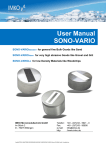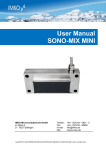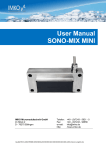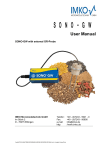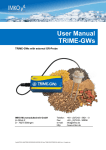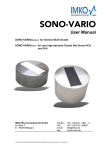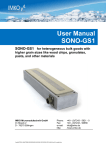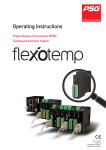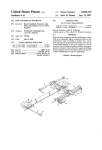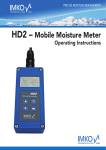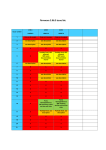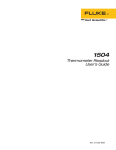Download User Manual SONO-VARIO
Transcript
User Manual SONO-VARIO SONO-VARIOLD for Moisture Measurement of low Density Grains IMKO Micromodultechnik GmbH Im Stöck 2 D - 76275 Ettlingen Telefon: Fax: e-mail: http: +49 - (0)7243 - 5921 - 0 +49 - (0)7243 - 90856 [email protected] //www.imko.de I:\publik\TECH_MAN\TRIME-SONO\ENGLISH\SONO-VARIO LD Grain\SONO-VARIO-LD-Grain-MAN-Vers2_1-english.doc 2/48 User Manual for SONO-VARIO LD As of 11. June 2014 Thank you for buying an IMKO moisture probe. Please carefully read these instructions in order to achieve best possible results with your SONO-VARIO LD probe for the in-line moisture measurement. Should you have any questions or suggestions regarding your new probe after reading, please do not hesitate to contact our authorised dealers or IMKO directly. We will gladly help you. List of Content: 1. Instrument Description SONO-VARIOLD ................................................................................... 4 The patented TRIME TDR-Measuring Method ............................................................. 4 1.1.2. TRIME compared to other Measuring Methods ........................................................... 4 1.1.3. Areas of Application for the SONO-VARIOLD ................................................................. 4 1.2. 2. ® Mode of Operation ................................................................................................................. 5 1.2.1. Measurement value collection with pre-check, average value and filtering ................... 5 1.2.2. Determination of the mineral Concentration................................................................... 5 1.2.3. Temperature Measurement ............................................................................................ 5 1.2.4. Temperature compensation when working at high temperatures .................................. 5 1.2.5. Analogue Outputs ........................................................................................................... 6 1.2.6. The serial RS485 interface ............................................................................................. 7 1.2.7. Error Reports and Error Messages ................................................................................ 7 Configuration of the Measure Mode ......................................................................................... 8 2.1. Operation Mode CA and CF at non-continuous Material Flow .............................................. 8 2.1.1. Average Time in the measurement mode CA and CF ................................................. 10 2.1.2. Filtering at material gaps in mode CA and CF ............................................................. 10 2.1.3. Mode CC – automatic summation of a moisture quantity during one batch process. 11 2.1.4. Mode CH – Automatic Moisture Measurement in one Batch ..................................... 12 2.2. 3. ® 1.1.1. Overview of single modes for different applications ............................................................ 13 Initial operation and installation .............................................................................................. 14 3.1. Adjustments for initial operation .......................................................................................... 14 3.1.1. Selection of the calibration curve Cal1 to Cal15 .......................................................... 14 3.1.2. Calibration curves with or without temperature compensation .................................... 14 3.2. Calibration Curves Cal1 to Cal15 ........................................................................................ 15 3.2.1. Selection and application of the reference method ...................................................... 16 3.2.2. Recording measurement data in trial operation ........................................................... 17 3.2.3. Setting the calibration curve (adjustment) .................................................................... 17 3.2.4. 3.3. Creating a linear Calibration Curve for a specific Material ................................................... 19 3.3.1. 4. 6. 4.1.1. Connection Plug and Plug Pinning ............................................................................... 22 4.1.2. Analogue Output 0..10V with a Shunt-Resistor ............................................................ 23 4.1.3. Connection diagramm with SONO-VIEW ..................................................................... 23 Connection of the RS485 to the SM-USB Module from IMKO ............................................ 24 Quick Guide for the Commissioning Software SONO-CONFIG ............................................ 27 5.1.1. Scan of connected SONO probes on the serial interface ............................................. 27 5.1.2. Configuration of Measure Mode and serial SONO-interface ........................................ 28 5.1.3. Analogue outputs of the SONO probe .......................................................................... 28 5.1.4. Selection of the individual Calibration Curves .............................................................. 29 5.1.5. “Test” run in the respective Measurement Mode .......................................................... 30 5.1.6. “Measure” run in Datalogger-Operation ........................................................................ 30 5.1.7. Basic Balancing in Air and Water .................................................................................. 31 Installation of the Probe ............................................................................................................ 32 6.1. Further important Assembly Instructions.............................................................................. 33 6.2. What could be done if the Material Flow is not optimal? ...................................................... 34 6.3. Further Assembly Instructions .............................................................................................. 35 6.4. Assembly Dimensions .......................................................................................................... 36 6.5. Mounting in curved Surfaces ................................................................................................ 38 6.6. Gas- and waterproofed Installation ...................................................................................... 39 6.7. Installation in a conveyor pipeline ........................................................................................ 40 6.8. Exchange of the Probe Head of the VARIOXtrem/LD ......................................................... 41 6.8.1. 7. Nonlinear calibration curves .......................................................................................... 20 Connectivity to SONO Probes .................................................................................................. 21 4.2. 5. 3/48 An example for wheat ................................................................................................... 18 Basic Balancing of a new Probe Head.......................................................................... 42 Technical Data SONO-VARIO LD ............................................................................................. 43 4/48 1. Instrument Description SONO-VARIOLD ® 1.1.1. The patented TRIME TDR-Measuring Method The TDR technology (Time-Domain-Reflectometry) is a radar-based dielectric measuring procedure at which the transit times of electromagnetic pulses for the measurement of dielectric constants, respectively the moisture content are determined. SONO-VARIO LD consists of a high grade steel casing with a wear-resistant sensor head with ceramic window. An integrated TRIME TDR measuring transducer is installed into the casing. A high frequency TDR pulse (1GHz), passes along wave guides and generates an electro-magnetic field around these guides and herewith also in the material surrounding the probe. Using a new patented measuring method, IMKO has achieved to measure the transit time of this pulse with a -12 resolution of 1 picosecond (1x10 ), consequently determine the moisture and the conductivity of the measured material. The established moisture content, as well as the conductivity, respectively the temperature, can either be uploaded directly into a SPC via two analogue outputs 0(4) ...20 mA or recalled via a serial RS485 interface. ® 1.1.2. TRIME compared to other Measuring Methods ® In contrary to conventional capacitive or microwave measuring methods, the TRIME technology (Time-Domain-Reflectometry with Intelligent Micromodule Elements) does not only enable the measuring of the moisture but also to verify if the mineral concentration specified in a recipe has been complied with. This means more reliability at the production. TRIME-TDR technology operates in the ideal frequency range between 600MHz and 1,2 GHz. Capacitive measuring methods (also referred to as Frequency-Domain-Technology) , depending on the device, operate within a frequency range between 5MHz and 40MHz and are therefore prone to interference due to disturbance such as the temperature and the mineral contents of the measured material. Microwave measuring systems operate with high frequencies >2GHz. At these frequencies, nonlinearities are generated which require very complex compensation. For this reason, microwave measuring methods are more sensitive in regard to temperature variation. SONO probes calibrate themselves in the event of abrasion due to a novel and innovative probe design. This consequently means longer maintenance intervals and, at the same time, more precise measurement values. The modular TRIME technology enables a manifold of special applications without much effort due to the fact that it can be variably adjusted to many applications. 1.1.3. Areas of Application for the SONO-VARIOLD SONO-VARIO LD is suited for moisture measurement of different grain types. An installation is possible into containers, hoppers and above conveyor belts. 5/48 1.2. Mode of Operation 1.2.1. Measurement value collection with pre-check, average value and filtering SONO probes measure internally at very high cycle rates of 10 kHz and are updating the measurement value at a cycle time of 250 milliseconds at the analogue output. In these 250 milliseconds a probe-internal pre-check of the moisture values is already carried out, i.e. only plausible and physically checked and pre-averaged single measurement values are be used for the further data processing. This increases the reliability for the recording of the measured values to a downstream control system significantly. In the Measurement Mode CS (Cyclic-Successive), an average value is not accumulated and the cycle time here is 200 milliseconds. In the Measurement Mode CA, CF, CC and CK, not the momentarily measured individual values are directly issued, but an average value is accumulated via a variable number of measurements in order to filter out temporary variations. These variations can be caused by inhomogeneous moisture distribution in the material surrounding the sensor head. The delivery scope of SONO-VARIO LD includes suited parameters for the averaging period and a universally applicable filter function deployable for currently usual applications. The time for the average value accumulation, as well as various filter functions, can be adjusted for special applications. 1.2.2. Determination of the mineral Concentration With the radar-based TRIME measurement method, it is now possible for the first time, not only to measure the moisture, but also to provide information regarding the conductivity, respectively the mineral concentration or the composition of a special material. Hereby, the attenuation of the radar pulse in the measured volume fraction of the material is determined. This novel and innovative measurement delivers a radar-based conductance value (RbC – Radar-based-Conductivity) in dS/m as characteristic value which is determined in dependency of the mineral concentration and is issued as an unscaled value. The RbC-measurement range of the SONO-VARIO LD is 0..12dS/m 1.2.3. Temperature Measurement A temperature sensor is installed into the SONO-VARIO LD which establishes the casing temperature 3mm beneath the sensor surface. The temperature can optionally be issued at the analogue output 2. As the TRIME electronics operates with a power of approximately 1.5 W, the probe casing does slightly heat up. A measurement of the material temperature is therefore only possible to a certain degree. The material temperature can be determined after an external calibration and compensation of the sensor self-heating. 1.2.4. Temperature compensation when working at high temperatures Despite SONO probes show a generally low temperature drift, it could be necessary to compensate a temperature drift in special applications. SONO probes offer two possibilities for temperature compensation. A) Temperature compensation of the internal SONO-electronic With this method of temperature compensation, a possible temperature drift of the SONO-electronic can be compensated. Because the SONO-electronic shows a generally low temperature drift, SONO probes are presetted at delivery for standard ambient conditions with the parameter TempComp=0.2. Dependent on SONO probe type, this parameter TempComp can be adjusted for higher temperature ranges (up to 100°C) to values up to TempComp=0.75. But it is to consider that it is necessary to make a Basic-Balancing of the SONO probe in air and water, if the parameter TempComp is changed to another value as TempComp=0.2. The parameter TempComp can be changed with the software tool SONO-CONFIG, in the menu "Calibration" and the window "TemperatureCompensation". 6/48 B) Temperature compensation for the measured material Water and special materials like oil fruits and others, can show a dependency of the dielectric permittivity when using SONO probes at high temperature ranges. The dielectric permittivity is the raw parameter for measuring water content with SONO probes. If special materials show a very special temperature drift, e.g. in lower temperatures a higher drift than in higher temperatures, than it could be necessary to make a more elaborate temperature compensation. Therefore it is necessary to measure in parallel the material temperature with the temperature sensor which is placed inside the SONO probe. Normally this is related with high efforts in laboratory works. SONO probes offer the possibility to set special temperature compensation parameters t0 to t5 for every calibration curve Cal1 of Cal15 (see chapter “Selection of the individual calibration curve”). Please contact IMKO should you need any assistance in this area. 1.2.5. Analogue Outputs The measurement values are issued as a current signal via the analogue output. With the help of the service program SONO-CONFIG, the SONO-VARIO LD can be set to the two versions for 0..20mA or 4..20mA. Furthermore, it is also possible to variably adjust the moisture dynamic range e.g. to 0-10%, 0-20% or 0-30%. For a 0-10V DC voltage output, a 500R resistor can be installed in order to reach a 0..10V output. Analogue Output 1: Moisture in % (0…20%, variable adjustable) Analogue Output 2: Conductivity (RbC) or optionally the temperature. In addition, there is also the option to split the analogue output 2 into two ranges: into 4..11mA for the temperature and 12..20mA for the conductivity. The analogue output 2 hereby changes over into an adjustable one-second cycle between these two (current) measurement windows. For the analogue outputs 1 and 2 there are thus two adjustable options: Analog Output: (two possible selections) 0..20mA 4..20mA Output Channel 1 and 2: (three possible selections) 1. Moist, Temp. Analogue output 1 for moisture, output 2 for temperature. or 2. Moist, Conductivity Analogue output 1 for moisture, output 2 for conductivity in a range of 0..20dS/m. or 3. Moist, Temp/Conductivity Analogue output 1 for moisture, output 2 for both, temperature and conductivity with an automatic current-window change. For analogue output 1 and 2 the moisture dynamic range and temperature dynamic range can be variably adjusted. The moisture dynamic range should not exceed 100% Moisture Range: Maximum: e.g. 20 for sand (Set in %) Minimum: 0 Temp. Range: Maximum: 70 °C Minimum: 0 °C 7/48 1.2.6. The serial RS485 interface SONO-VARIO LD is equipped with a standard RS485 interface to serially readout individual parameters or measurement values. An easy to implement data transfer protocol enables the connection of several sensors/probes at the RS485-Interface. In addition, the SONO-VARIO LD can be directly connected to the USB port of a PC, in order to adjust individual measuring parameters or conduct calibrations, via the RS485 USB Module which can be provided by IMKO. 1.2.7. Error Reports and Error Messages SONO-VARIO LD is very fault-tolerant. This enables failure-free operation. Error messages can be recalled via the serial RS485 interface. 8/48 2. Configuration of the Measure Mode The configuration of SONO- probe is preset in the factory before delivery. A process-related later optimisation of this device-internal setting is possible with the help of the service program SONOCONFIG. For all activities regarding parameter setting and calibration the probe can be directly connected via the RS485 interface to the PC via a RS485 USB-Module which is available from IMKO. The following settings of SONO probes can be amended with the service program SONO-CONFIG: Measurement-Mode and Parameters: Measurement Mode A-On-Request (only in network operation for the retrieval of measurement values via the RS485 interface). Measurement Mode C Cyclic: SONO-VARIO is supplied ex-factory with suited parameters. For most applications, mode CA could be usable. Up to 6 different modes can be adjusted: Mode CS: (Cyclic-Successive) For very short measuring processes (e.g. 5…20 seconds) without floating average, with internal up to 100 measurements per second and a cycle time of 250 milliseconds at the analogue output. Measurement mode CS can also be used for getting raw data from the SONO-probe without averaging and filtering. Mode CA: (Cyclic-Average-Filter) For relative short measuring processes with continual average value, filtering and an accuracy of up to 0.1% Mode CF: (Cyclic-Float-Average) for continual average value with filtering and an accuracy of up to 0.1% for very slowly measuring processes, e.g. in fluidized bed dryers, conveyor belts, etc. Mode CK: (Cyclic-Kalman-Filter with Boost) Standard setting for SONO-MIX for use in fresh concrete mixer with continual average value with special dynamic Kalman filtering and an accuracy of up to 0.1%. Mode CC: (Cyclic Cumulated) with automatic summation of a moisture quantity during one batch process. Mode CH: (Cyclic Hold) similar to Mode CC but without summation. For applications in the construction industry. If the SONO-probe is installed under a silo flap, Mode CH can measure moisture when batch cycles are very short, down to 2 seconds. Mode CH executes an automatic filtering, e.g. if dripping water occurs. Each of these settings will be preserved after shut down of the probe and is therefore stored on a permanent basis. 2.1. Operation Mode CA and CF at non-continuous Material Flow For mode CA and CF the SONO probes are supplied ex-factory with suited parameters for the averaging time and with a universally deployable filter function suited for most currently applications. The setting options and special functions of SONO probes depicted in this chapter are only rarely required. It is necessary to take into consideration that the modification of the settings or the realisation of these special functions may lead to faulty operation of the probe! For applications with non-continuous material flow, there is the option to optimise the control of the measurement process via the adjustable filter values Filter-Lower-Limit, Filter-Upper-Limit and the time constant No-Material-Keep-Time. The continual/floating averaging can be set with the parameter Average-Time. 9/48 Parameters in the Measurement Mode CA, CF, CC, CH and CK Function Average-Time Standard Setting: 2 Setting Range: 1…20 The time (in seconds) for the generation of the average value can be set with this parameter. Filter-Upper-Limit-Offset Standard Setting: 20 Setting Range: 1….20 With the setting of 20, this parameter must be disabled for Mode CK ! Too high measurement values generated due to metal wipers or blades are filtered out. The offset value in % is added to the dynamically calculated upper limit. Filter-Lower-Limit-Offset Standard Setting: 20 Setting Range: 1.….20 With the setting of 20, this parameter must be disabled for Mode CK ! Too low measurement values generated due to insufficient material at the probe head are filtered out. The offset value in % is subtracted from the dynamically calculated lower limit with the negative sign. Upper-Limit-Keep-Time Standard Setting: 10 Setting Range: 1...100 With the setting of 100, this parameter must be disabled for Mode CK ! The maximum duration (in seconds) of the filter function for Upper-Limit-failures (too high measurement values) can be set with this parameter. Lower-Limit-Keep-Time Standard Setting: 10 Setting Range: 1...100 With the setting of 100, this parameter must be disabled for Mode CK ! The maximum duration (in seconds) of the filter function for Lower-Limit-failures (too low measurement values) for longer-lasting "material gaps", ie the time in which no material is located on the probe, can be bridged. Moisture Threshold (in %-moisture) Standard Setting: 1 Setting Range: 1….20 The accumulation of moisture values starts above the „Moisture Threshold“ and the analogue signal is output. The accumulation pauses if the moisture level is below the threshold value. No-Material-Delay (in seconds) The accumulation stopps if the moisture value is below the moisture threshold. The SONO probes starts again in a new batch with a new accumulation after the time span of the “No-Material-Delay” is exceeded. Standard Setting: 5 Setting Range: 1….20 Boost Standard Setting: 35 Setting Range: 1….100 Automatic summation stops, if threshold is below „NoMaterial-Delay“. After expiration of „No-Material-Delay“, the probe is ready to start a new summation in a new batch. Offset Standard Setting: 0.5 Setting Range: 0 ….5 Non-linearities in the process can be compensated. E.g. in fluid bed dryers non-linearities can occur due to changes in the material density during the drying process. “Offset” works together with the parameter “Average-time”. Weight Standard Setting: 5 Setting Range: 0 …..5 Smoothing factor for measured values. This parameter influences the reaction/response time. Invalid Measure Count Standard Setting: 2 Setting Range: 0….. 10 This par-meter is de-activated in mode CK ! This parameter works only in mode CC or CH ! Number of discarded (poor) measurement values after the start of a new batch, when „No-Material-Delay“ has triggered. The first measurement values, e.g. due to dripping water, will be rejected. 10/48 2.1.1. Average Time in the measurement mode CA and CF SONO probes establishes every 200 milliseconds a new single measurement value which is incorporated into the continual averaging and issues the respective average value in this timing cycle at the analogue output. The averaging time therefore accords to the “memory” of the SONO probe. The longer this time is selected, the more inert is the reaction rate, if differently moist material passes the probe. A longer averaging time results in a more stable measurement value. This should in particular be taken into consideration, if the SONO probe is deployed in different applications in order to compensate measurement value variations due to differently moist materials. At the point of time of delivery, the Average Time is set to 4 seconds. This value has proven itself to be useful for many types of applications. At applications which require a faster reaction rate, a smaller value can be set. Should the display be too “unstable”, it is recommended to select a higher value. 2.1.2. Filtering at material gaps in mode CA and CF A SONO probe is able to identify, if temporarily no or less material is at the probe head and can filter out such inaccurate measurement values (Filter-Lower-Limit). Particular attention should be directed at those time periods in which the measurement area of the probe is only partially filled with material for a longer time, i.e. the material (sand) temporarily no longer completely covers the probe head. During these periods (Lower-Limit-Keep-Time), the probe would establish a value that is too low. The Lower-Limit-Keep-Time sets the maximum possible time where the probe could determine inaccurate (too low) measurement values. Furthermore, the passing or wiping of the probe head with metal blades or wipers can lead to the establishment of too high measurement values (Filter-Upper-Limit). The Upper-Limit-Keep-Time sets the maximum possible time where the probe would determine inaccurate (too high) measurement values. Using a complex algorithm, SONO probes are able to filter out such faulty individual measurement values. The standard settings in the Measurement Mode CA and CF for the filter functions depicted in the following have proven themselves to be useful for many applications and should only be altered for special applications. It is appropriate to bridge material gaps in mode CA with Upper- and Lower-Limit Offsets and KeepTime. For example the Lower-Limit Offset could be adjusted with 2% with a Lower-Limit Keep-Time of 5 seconds. If the SONO probe determines a moisture value which is 2% below the average moisture value with e.g. 8%, than the average moisture value will be frozen at this value during the Lower-Limit Keep-Time of 5 seconds. In this way the material gap can be bridged. This powerful function inside the SONO probe works here as a highpass filter where the higher moisture values are used for building an average value, and the lower or zero values are filtered out. In the following this function is described with SONO parameters. Sufficient material for an accurately moisture measurement value of e.g.8% Material gaps over e.g. 3 seconds which must be bridged for an accurately measurement with a Lower-Limit Keep-Time of 5 seconds. The following parameter setting in mode CA fits a high pass filtering for bridging material gaps. 11/48 The Filter Upper-Limit is here deactivated with a value of 20, the Filter Lower-Limit is set to 2%. With a Lower-Limit Keep-Time of 5 seconds the average value will be frozen for 5 seconds if a single measurement value is below the limit of 2% of the average value. After 5 seconds the average value is deleted and a new average value building starts. The Keep-Time function stops if a single measurement value lies within the Limit values. 2.1.3. Mode CC – automatic summation of a moisture quantity during one batch process Simple PLCs are often unable to record moisture measurement values during one batch process with averaging and data storage. Furthermore there are applications without a PLC, where accumulated moisture values of one batch process should be displayed to the operating staff for a longer time. Previously available microwave moisture probes on the market show three disadvantages: 1. Such microwave probes need a switching signal from a PLC for starting the averaging of the probe. This increases the cabling effort. 2. Time delays can occur during the summation time with a trigger signal which leads to measurement errors. This is particularly disadvantageous for small batches, recipe errors can occur. 3. Material gaps during one batch process will lead to zero measurement values which falsify the accumulated measurement value considerably, recipe errors can occur. Unlike current microwave probes, SONO probes work in mode CC with automatic summation, where it is really ensured that material has contact with the probe. This increases the reliability for the moisture measurement during one complete batch process. The summation is only working if material fits at the probe. Due to precise moisture measurement also in the lower moisture range, SONO probes can record, accumulate and store moisture values during a complete batch process without an external switching or trigger signal. The SONO probe “freezes” the analogue signal as long as a new batch process starts. So the PLC has time enough to read in the “freezed” moisture value of the batch. For applications without a PLC the “freezed” signal of the SONO probe can be used for displaying the moisture value to a simple 7-segment unit as long as a new batch process starts. With the parameter Moisture Threshold the SONO probe can be configured to the start moisture level where the summation starts automatically. Due to an automatic recalibration of SONO probes, it is ensured that the zero point will be precisely controlled. The start level could be variably set dependent to the plant. Recommended is a level with e.g. 0.5% to 1%. With the parameter No-Material-Delay a time range can be set, where the SONO probe is again ready to start a new batch process. Are there short material gaps during a batch process which are shorter than the “No-Material-Delay”, with no material at the probes surface, then the SONO probe pauses shortly with the summation. Is the pause greater as the “No-Material-Delay” then the probe is ready to start a new batch process. 12/48 How can the mode CC be used, if the SONO probe cannot detect the „moisture threshold“ by itself, e.g. above a conveyor belt if there is constantly material above the probe over a longer time: In this case, a short interrupt of the probe´s power supply, e.g for about 0.5 seconds with the help of a relay contact of the PLC, can restart the SONO probe at the beginning of the material transport. After this short interrupt the SONO probe starts immediately with the summarizing and averaging. Please note: It should be noted that no material sticks on the probes surface. Otherwise the moisture zero point of the probe will be shifted up and the probe would not be detect a moisture low value below the “Moisture-Threshold”. Time chart for mode CC 2.1.4. Mode CH – Automatic Moisture Measurement in one Batch Mode CH (Cyclic Hold) is identically to Mode CC but without summation. If the PLC already accumulates moisture values, than an additional automatic summation of a moisture quantity inside the SONO-probe during one batch process will produce errors. 13/48 Mode CH is for applications in the construction industry. If the SONO-probe is installed under a silo flap, Mode CH can measure moisture when batch cycles are very short, down to 2 seconds. Mode CH executes an automatic filtering, e.g. if dripping water occurs. 2.2. Overview of single modes for different applications The following table gives an overview about possible parameter settings in different modes: Application/ Installation and specific Parameters Sand/ Gravel under a silo flap Above a conveyor belt Inside a mixer Inside a fluid bed dryer Generally simple applications in a screw conveyor with filtering options due to metal spiral At the end of a screw conveyor Long term process Operating Mode CH CH CK CK CA CK CF AverageTime 2 2 5 5 10 10 30 FilterUpper-Limit Offset inactiv 100 inactiv 100 inactiv 100 inactiv 100 e.g. 20 inactiv 100 e.g. 20 FilterLower-Limit Offset inactiv 100 inactiv 100 inactiv 100 inactiv 100 e.g. 10 inactiv 100 e.g. 5 UpperLimit-KeepTime inactiv 10 inactiv 10 inactiv 10 inactiv 10 e.g. 10 inactiv 10 e.g. 10 LowerLimit-KeepTime inactiv 10 inactiv 10 inactiv 10 inactiv 10 e.g. 10 inactiv 10 e.g. 10 Moisture Threshold 0.1 0.1 0.1 0.1 - 0.1 - No-MaterialDelay 10 10 10 10 - inactiv - Boost 35 35 20 20 - 20 - Offset 0.5 0.5 1 1 - 1 - Weight 5 5 25 25 - 50 - Invalid Measure Count 2 2 inactiv inactiv - inactiv - For very difficult applications, where it is not certain, which mode is the best, we recommend to select mode CA with averaging time = 1 second. With help of the software SONO-CONFIG a data record can be stored directly during process conditions. After forwarding this data set to IMKO, we would be pleased to be at your disposal for finding the best suitable working mode. 14/48 3. Initial operation and installation 3.1. Adjustments for initial operation The term “adjustment” refers, in this case, to the correct setting of the calibration curve and zero offset depending on grain type and installation place where an absolute moisture value with an accuracy of +-0,3% is important. The SONO-VARIO LD can only be adjusted when installed in the plant as the location and the bulk density of the grain have a significant influence on moisture measurement. Adjustment must be carried out separately for every dried product. Moisture measurement is dependent on the following parameters: Location (e.g. metallic objects within the field of measurement) Bulk density of the grain Type of grain (product) As soon as one of these parameters changes, another calibration curve or an adjustment must be chosen. If all possible grain types are adjusted, it is only necessary to select the right calibration curve when changing the grain type in the plant. 3.1.1. Selection of the calibration curve Cal1 to Cal15 Up to 15 different calibration curves (CAL1 ... Cal15) are stored inside the SONO-VARIO LD. They can be activated in two ways: A: With the stand alone module SONO-VIEW the calibration curve can be selected and activated. B: The calibration curve (Cal1. .15) can be activated with the module SM-USB which is connected via a PC. In the menu "Calibration" and in the window “Material Property Calibration" by selecting the desired calibration curve (Cal1...Cal15) and with using the button “Set Active Calib”. The finally desired and possibly altered calibration curve (Cal1. .15) which is activated after switching on the probes power supply will be adjusted with the button "Set Default Calib”. 3.1.2. Calibration curves with or without temperature compensation Installation at the discharge hopper: For displaying correct moisture values it is to taken into account that a suitable calibration curve is to adjust, depending on grain type. A zero offset of SONOVARIO LD could be also necessary due to installation place. If the outfeed is continually and the SONO-VARIO LD is continually covered with grain, then the calibration curve has to be selected “with TC” (Temperature Compensation). However if the outfeed is batch by batch, then the calibration curve has to be selected “without TC”, because the temperature sensor at the rod tip of the GR probe measures most of the time the air temperature, not the grain temperature, which would lead to measurement failures The following charts (Cal.1 .. Cal15) show different selectable calibration curves which are stored inside the SONO-VARIO LD. Plotted is on the y-axis the gravimetric moisture (MoistAve) and on the x-axis depending on the calibration curve the associated radar time tpAve in picoseconds. With the software SONO-CONFIG the radar time tpAve is shown on the screen parallel to the moisture value MoistAve (see "Quick Guide for the Software SONO-CONFIG). 15/48 3.2. Calibration Curves Cal1 to Cal15 16/48 Calibration Curve Recommended for grain type Bulk density of grain type Cal1 Maize, without TC (TC = Temperature Compensation) 0,75 Installation at the discharge hopper. The outfeed is batch by batch and it is not secured, that the SONOVARIO LD is continually covered with grain. Cal2 Maize, with TC 0,75 A: An installation at the beginning of the heating zone is not allowed due to high temperature range. (pre-setted after delivery) Application B: Installation at the discharge hopper. The outfeed is continually and the SONO-VARIO LD is continually covered with grain. Cal3 Wheat without TC 0,75 Pre-installed like Cal1 Cal4 Wheat with TC 0,75 Pre-installed like Cal2 Cal5 Rye without TC 0,72 Pre-installed like Cal1 Cal6 Rye with TC 0,72 Pre-installed like Cal2 Cal7 Barley without TC 0,63 Special calibration curve Cal8 Barley with TC 0,63 Special calibration curve Cal9 Rape and oilseeds 0.65 ? without TC No temperature compensation necessary! Cal10 Sunflower seeds without TC 0,30 No temperature compensation necessary! Cal11 Soya without TC 0,65 Special calibration curve Cal12 Soya with TC 0,65 Special calibration curve Cal13 Cal14 Cal15 1/10 tp Radar time and reference calibration for test 3.2.1. Selection and application of the reference method In order to adjust the SONO-VARIO LD for precise absolute measurements at the discharge, an offline measurement method must be available to serve as a reference. It must provide a high degree of absolute precision and function with large sample volumes Most commercially available grain-moisture measuring systems leave a great deal to be desired regarding both of these aspects! The SONO-VARIO LD measures the average value continuously over a volume of 1-2 litres. In moving grain, the measurement volume acquired in the averaging time increases many times over. It therefore requires a lot of time and effort to check this very representative value with a reference instrument that shows a sample quantity in the millilitre range. There are also factors that can affect measurement, such as temperature and conductivity, that can be ignored when using SONO-VARIO LD due to the TDR radar method of measurement. 17/48 Thus, the most suitable method for determining the exact moisture of the grain is to use a drying oven. Here, too, the sample volume is of decisive importance and should be at 0.5 litres. When extracting the sample and taking reference measurements, the following must be observed: The samples for the reference measurements should be extracted from as close as possible to the probe. The distribution of moisture in the grain dryer can vary greatly. When using a calibrated instrument with small sample volumes, several samples must be extracted and their arithmetical average calculated. Please note that calibrated instruments can also produce incorrect measurements that can lie between 2% in the lower and even 5% in the upper moisture range. After the dryer or the silo has been filled, the SONO-VARIO LD moisture value must show a valid reading. 3.2.2. Recording measurement data in trial operation The selection of the calibration curve can only be adjusted in real operation or in realistic trial operation. The following description is based on the implementation of the SONO-VARIO LD at the discharge, in the delivery or in the storage area. As a general rule, only the moisture range close to the reference input is of significance for trial operation, i.e. when determining the switch position for maize, checking should be done at about 15%. It is more important that the SONO-VARIO LD is exactly correct in the lower area of measurement. It is of less importance whether SONO-VARIO LD measures 26% instead of 28% in the upper range! When extracting a sample or checking the lower reference input (e.g. 15% ), a single sample is of course insufficient. A single sample, possibly even extracted from quite a different point than in the direct vicinity of the probe, is not at all representative, i.e. several samples must be taken directly at the probe and averaged! At the start of trial operation, the suitable calibration curve can be set. When all the preparations for extracting samples and measuring them have been made, the grain dryer can be started up. Now, a sample of grain must be taken continuously, ideally every 15 minutes. The SONO-VARIO LD reading and the selected calibration curve are to be noted simultaneously with every extracted sample. This is compared with the appropriate offline-determined reference value, which is also to be noted. As soon as the moisture is near the target moisture, the calibration curve should be set to the best possible value, which is the nearest to the reference value. In the following you will find a ready-to-use form for entering the measurements. Where continuous-flow dryers are concerned, at least 10 to 20 measurements should be available in the range between the minimum and maximum permissible moisture content after drying. The measurements from the still very damp discharged grain during the charge phase should be noted but not used for the purposes of adjustment. For rotary dryers, only the measurements take towards the end of the drying process are of relevance to adjustment. Here, too, at least 10 measurements are to have been documented. Density and moisture distribution effects in the grain can cause too low measurements during the first one to two hours. These values should not be used for the adjustment. 3.2.3. Setting the calibration curve (adjustment) The appropriate setting of the calibration curve should be determined on the adjustment protocol. Only the measurements near the target moisture should be taken into account. 18/48 3.2.4. An example for wheat Note: SONO-VARIO LD is pre-installed to calibration curve … for wheat. A continuous-flow dryer is to be set for wheat. A SONO-VARIO LD has been installed whose probe is located in the direct vicinity of the discharge point. To start with, the calibration curve is set to Cal…. for wheat. The dryer is started up and measurement recording commences. It is not until the moisture at the discharge point falls below 18% that the measurements become of real interest and can be used for the adjustment process. Analysis can start as soon as about 10 to 20 measurements are available in the range from 12% to 18%. Reference measurement TRIME-GW, Level 1 TRIME-GW deviation 17.9% 24.6% 1 17.3% 17.6% 8 17.8% 17.3% 8 17.1% 16.8% 8 16.8% 16.2% 8 16.5% 15.8% 8 15.8% 16.0% 7 15.1% 15.6% 7 14.5% 14.7% 7 13.9% 14.0% 7 13.3% 13.5% 7 19/48 3.3. Creating a linear Calibration Curve for a specific Material The calibration curves Cal1 to Cal15 can be easily created or adapted for specific materials with the help of SONO-CONFIG. Therefore, two measurement points need to be identified with the probe. Point P1 at dried material and point P2 at moist material where the points P1 and P2 should be far enough apart to get a best possible calibration curve. The moisture content of the material at point P1 and P2 can be determined with laboratory measurement methods (oven drying). It is to consider that sufficient material is measured to get a representative value. Under the menu "Calibration" and the window "Material Property Calibration" the calibration curves CAL1 to Cal15 which are stored in the SONO probe are loaded and displayed on the screen (takes max. 1 minute). With the mouse pointer individual calibration curves can be tested with the SONOprobe by activating the button "Set Active Calib". The measurement of the moisture value (MoistAve) with the associated radar time tpAve at point P1 and P2 is started using the program SONO-CONFIG in the sub menu "Test" and "Test in Mode CF" (see "Quick Guide for the Software SONO- CONFIG"). Step 1: The radar pulse time tpAve of the probe is measured with dried material. Ideally, this takes place during operation of a mixer/dryer in order to take into account possible density fluctuations of the material. It is recommended to detect multiple measurement values for finding a best average value for tpAve. The result is the first calibration point P1 (e.g. 70/0). I.e. 70ps (picoseconds) of the radar pulse time tpAve corresponds to 0% moisture content of the material. But it would be also possible to use a higher point P1´ (e.g. 190/7) where a tpAve of 190ps corresponds to a moisture content of 7%. The gravimetric moisture content of the material, e.g. 7% has to be determined with laboratory measurement methods (oven drying). Step 2: The radar pulse time tpAve of the probe is measured with moist material. Ideally, this also takes place during operation of a mixer/dryer. Again, it is recommended to detect multiple measurement values of tpAve for finding a best average value. The result is the second calibration point P2 with X2/Y2 (e.g. 500/25). I.e. tpAve of 500ps corresponds to 25% moisture content. The gravimetric moisture content of the material, e.g. 25% has to be determined with laboratory measurement methods (oven drying). Step 3: With the two calibration points P1 and P2, the calibration coefficients m0 and m1 can be determined for the specific material (see next page). Step 4: The coefficients m1 = 0.0581 and m0 = -4.05 (see next page) for the calibration curve Cal14 can be entered directly by hand and are stored in the probe by pressing the button “Set”. The name of the calibration curve can also be entered by hand. The selected calibration curve (e.g. Cal14) which is activated after switching on the probes power supply will be adjusted with the button "Set Default Calib”. Attention: Use “dot” as separator (0.0581), not comma ! 20/48 3.3.1. Nonlinear calibration curves SONO probes can also work with non-linear calibration curves with polynomials up to 5th grade. Therefore it is necessary to calibrate with 4…8 different calibration points. To calculate nonlinear coefficients for polynomials up to 5th grade, an EXCEL software tool from IMKO can be used (on request). It is also possible to use any mathematical program like MATLAB for finding a best possible nonlinear calibration curve with suitable coefficient parameters m0 to m5 which can be entered into the probe with help of SONO-CONFIG. The following diagram shows a sample calculation for a linear calibration curve with the coefficients m0 and m1 for a specific material. 21/48 4. Connectivity to SONO Probes 22/48 4.1.1. Connection Plug and Plug Pinning SONO-VARIO LD is supplied with a 10-pole MIL flange plug. Assignment of the 10-pole MIL Plug and sensor cable connections: Plug-PIN Sensor Connections Lead Colour Lead Colour A +7V….24V Power Supply red red B 0V Blue Blue D 1. Analogue Positive (+) Moisture Green Green E 1. Analogue Return Line (-) Moisture yellow yellow F RS485 A white white G RS485 B brown brown C (rt) IMP-Bus grey/pink grey/pink J (com) IMP-Bus blue/red blue/red K 2. Analogue Positive (+) Pink Pink E 2. Analogue Return Line (-) Grey Grey H Screen (is grounded at the sensor. The plant must be properly grounded!) transparent transparent Power Supply 23/48 4.1.2. Analogue Output 0..10V with a Shunt-Resistor There are PLC´s which have no current inputs 0..20mA, but voltage inputs 0..10V. With the help of a shunt resistor with 500 ohm (in the delivery included) it is possible to generate a 0..10V signal from the current signal 0..20mA. The 500 ohm shunt resistor should be placed at the end of the line resp. at the input of the PLC. Following drawing shows the circuit principle. 4.1.3. Connection diagramm with SONO-VIEW 24/48 4.2. Connection of the RS485 to the SM-USB Module from IMKO The SM-USB provides the ability to connect a SONO probe either to the standard RS485 interface or to the IMP-Bus from IMKO. In fact that the IMP-Bus is more robust and enables the download of a new firmware to the SONO probe, the SONO probes are presetted ex-factory to the IMP-Bus. So it is recommended to use the IMP-Bus for a serial communication. Both connector ports are shown in the drawing below. The SM-USB is signalling the status of power supply and the transmission signals with 4 LED´s. When using a dual-USB connector on the PC, it is possible to use the power supply for the SONO probe directly from the USB port of the PC without the use of the external AC adapter. How to start with the USB-Module SM-USB from IMKO Install USB-Driver from USB-Stick. Connect the SM-USB to the USB-Port of the PC and the installation will be accomplished automatically. Install Software SONOConfig-SetUp.msi from USB-Stick. Connection of the SONO probe to the EX9531 via RS485A, RS485B and 0V. Check the setting of the COM-Ports in the Device-Manager und setup the specific COM-Port with the Baudrate of 9600 Baud in SONO-CONFIG with the button "Bus" and "Configuration" (COM1COM15 is possible). Start “Scan probes” in SONOConfig. The SONO probe logs in the window „Probe List“ after max. 30 seconds with its serial number. 25/48 Note 1: In the Device-Manager passes it as follows: Control Panel System Hardware Device-Manager Under the entry “Ports (COM & LPT) now the item “USB Serial Port (COMx)” is found. COMx set must be between COM1….COM9 and it should be ensured that there is no double occupancy of the interfaces. If it comes to conflicts among the serial port or the USB-SM has been found in a higher COM-port, the COM port number can be adjusted manually: By double clicking on "USB Serial Port" you can go into the properties menu, where you see "connection settings" – with "Advanced" button, the COM port number can be switched to a free number. 26/48 After changing the COMx port settings, SONO-CONFIG must be restarted. 27/48 5. Quick Guide for the Commissioning Software SONO-CONFIG With SONO-CONFIG it is possible to make process-related adjustments of individual parameters of the SONO probe. Furthermore the measurement values of the SONO probe can be read from the probe via the serial interface and displayed on the screen. In the menu "Bus" and the window "Configuration" the PC can be configured to an available COMxport with the Baudrate of 9600 Baud. 5.1.1. Scan of connected SONO probes on the serial interface In the menu "Bus" and the window "Scan Probes" the serial bus can be scanned for attached SONO probes (takes max. 30 seconds). SONO-CONFIG reports one or more connected and founded SONO probes with its serial number in the window “Probe List“. One SONO probe can be selected by klicking. 28/48 5.1.2. Configuration of Measure Mode and serial SONO-interface In "Probe List" with "Config" and "Measure Mode & Parameters” the SONO probe can be adjusted to the desired measure mode CA, CF, CS, CK, CC or CH (see Chapter “Configuration Measure Mode”). Furthermore the serial interface inside the SONO probe can be selected to IMP-Bus, RS485 or both interfaces. Due to very robust behavior it is recommended to select the IMP-Bus. 5.1.3. Analogue outputs of the SONO probe In the menu "Config" and the window "Analog Output" the analogue outputs of the SONO probe can be configured (see Chapter “Analogue outputs..”). 29/48 5.1.4. Selection of the individual Calibration Curves In the menu "Calibration" and the window "Material Property Calibration" the calibration curves CAL1 to Cal15 which are stored in the SONO probe are loaded and displayed on the screen (takes max. 1 minute). With the mouse pointer individual calibration curves can be activated and tested with the SONO-probe by activating the button "Set Active Calib". Furthermore, the individual calibration curves CAL1 to Cal15 can be adapted or modified with the calibration coefficients (see Chapter “Creating a linear calibration curve”). The desired and possibly altered calibration curve (Cal1. .15) which is activated after switching on the probes power supply can be adjusted with the button "Set Default Calib”. The calibration name can be entered in the window “Calibration Name”. The coefficients m0 to m1 (for linear curves) and m0 to m5 (for non-linear curves) can be entered and adjusted directly by hand with the buttons “Set” and “Save”. Possible are non-linear calibration curves with polynomials up to fifth order (m0-m5). Attention: Use “dot” as separator for m0 to m5 not comma ! 30/48 5.1.5. “Test” run in the respective Measurement Mode In the menu "Test" and the window "Test in Mode CA or CF" the measured moisture values “MoistAve” (Average) of the SONO probe are displayed on the screen and can be parallel saved in a file. In the menu "Test" and the window "Test in Mode CS" the measured single measurement values “Moist” (5 values per second) of the SONO probe are displayed on the screen and parallel stored in a file. In „Test in Mode A“ single measurement values (without average) are displayed on the screen and can also be stored in a file. Attention: for a test run in mode CA, CF, CS or A it must be ensured that the SONO probe was also set to this mode (Measure Mode CA, CF, CS, A). If this is not assured, the probe returns zero values. Following measurement values are displayed on the screen: MoistAve Moisture Value in % (Average) MatTemp Temperature EC-TRIME Radar-based-Conductivity EC-TRIME in dS/m (or mS/cm) TDRAve TDR-Signal-Level for special applications. DeltaCount Number of single measurements which are used for the averaging. tpAve Radar time (average) which corresponds to the respective moisture value. By clicking „Save“ the recorded data is saved in a text file in the following path: \SONO-CONFIG.exe-Pfad\MD\Dateiname The name of the text file Statis+SN+yyyymmddHHMMSS.sts is assigned automatically with the serial number of the probe (SN) and date and time. The data in the text file can be evaluated with Windows-EXCEL. 5.1.6. “Measure” run in Datalogger-Operation In the menu "Measure" it is possible to aquire and store measurement data from several SONO probes with variable and longer cycle rates in a datalogger-operation, e.g. to store measurement data during a long-term drying cycle. 31/48 5.1.7. Basic Balancing in Air and Water SONO probe heads are identical and manufactured precisely. After an exchange of a probe head it is nevertheless advisable to verify the calibration and to check the basic calibration and if necessary to correct it with a “Basic Balancing”. With a “Basic Balancing” two reference calibration measurements are to be carried out with known setpoints ("RefValues"). For the reference media, different calibration materials are used, dependent on the SONO probe type. For SONO probes with a ceramic measurement window, air and water (tap water) is used. For other SONO probes like SONO-GS1 glass beads are used for basic calibrations (on request). Attention: Before performing a “Basic Balancing” it must be ensured that the SONO probe was set to “Measure Mode” A. If this is not assured, the probe returns zero values. After a “Basic Balancing” the SONO probe has to be set to “Measure Mode C” again, because otherwise the probe would not measure continuously! In the menu "Calibration" and the window "Basic Balancing" the two set-point values of the radar time tp are displayed with 60ps and 1000ps. 1. Reference set-point A: tp=60ps in air (the surface of the probe head must be dry!!) The first set-point can be activated with the mouse pointer by clicking to No.1. By activating the button "Do Measurement" the SONO probe determines the first reference set-point in air. In the column „MeasValues“ the measured raw value of the radar time t is displayed (e.g. 1532.05 picoseconds). 2. Reference set-point B: tp=1000ps in water. The SONO probe head has to be covered with water in a height of about 50mm. The second set-point can be activated with the mouse pointer by clicking to No.2. By activating the button "Do Measurement" the SONO probe determines the second reference set-point in water. In the column „MeasValues“ the measured raw value of the radar time t is displayed. 3. By activating the button „Calculate Coeffs“ and „Coeffs Probe“ the alignment data is calculated automatically and is stored in the SONO probe non-volatile. With a “Test run” (in Mode A) the radar time tp of the SONO probe should be now 60ps in air and 1000ps in water. 32/48 6. Installation of the Probe The installation conditions are strongly influenced by the constructional circumstances of the installation facility. The ideal installation location must be established individually. For measuring sand, gravel and grit, the SONO-VARIO should ideally be installed under a silo valve, which has many advantages (see below). Installation of the SONO-VARIO for measuring sand, gravel and grit, under a silo valve or on a conveyor belt. Dependent on material, it is important to find the suitable angle of the mounting plate. It should be not too steep, but also not too flat and the flowing material should cover the probes surface completely during flowing. It should be mentioned, that with the innovative features of SONO-probes and an extremely rugged design, it is possible, to install a SONO-VARIO directly under valves of silos, also for gravel with 32mm size. The installation inside a silo could be also possible, but it must be observed, that during filling and emptying, no material (e.g. sand) can be stick on the probes surface, which could be result in measurement errors. The following instructions should be followed when installing the probe: The SONO-VARIO should be installed ideally under a valve of the silo, which has many advantages: 1. The material flows constant and therefore the material density is constant which guarantees more precise measurement values. 2. Due to higher material pressure, the probe´s surface is cleaned continously. Material sticking and therefore measurement errors are be prevented. 3. The SONO-VARIO can detect clearly the start and the end of a batch process. So the SONOVARIO can calculate an automatic summation of the moisture quantity during one batch process in mode CC. Even short batches with few material can be precisely measured. Further advantage is that the PLC programming can be made more simple without switching signals. Unfavourable conditions for moisture probes occur if the probes are installed inside silos or inside outlets. The picture shows how sticky and adhere sand can be, even at near-vertical walls. Furthermore a moisture probe can be seen which is installed directly inside the outlet of a silo, where sand can stick not only at the wall but also on the moisture probe. Such an installation place can lead to measurement failures because it cannot be controlled visually. 33/48 6.1. Further important Assembly Instructions The following instructions should be followed when installing the probe: The universal holder should be installed direct under a silo flap, so that the flowing material covers the moisture probe completely. The installation locations may not be situated beneath the inlets for additives. In case of an uneven base, the probe must be installed at the highest point of the base. No water may accumulate at the probe head as this could falsify the measurement. With the universal holder, deliverable by IMKO, the SONO-VARIO can be placed above a conveyor belt. Particularly with inhomogeneous or loose sand, the material can be constantly condensed, which leads to higher measurement results. Areas with strong turbulences are not ideal for the installation. There should be a continuous material flow above the probe head. For special installations inside mixing containers it should be noted that the stirring movement of blades should be conducted without gaps above the probe head. The probe should not be installed in the direct vicinity of electrical disturbing sources such as motors. In case of curved installation surfaces in containers, the centre of the probe head should be flush with the radius of the container wall without disturbing the radial material flow in the container. The probe may not project and come in contact with blades or wipers. The probe connector should be protected against splashing water after installation. Attention! Risk of Breakage! The probe head is made of special steel and a very wear-resistant ceramic plate in order to warrant for a long life-span of the probe. In spite of the robust and wear-resistant construction, the ceramic plate may not be exposed to any blows as ceramic is prone to breakage. In case of welding work at the plant, all probes must be completely electrically disconnected. Any damage caused by faulty installation is not covered by the warranty! Abrasive wear of sensor parts is not covered by the warranty! 34/48 6.2. What could be done if the Material Flow is not optimal? But even the best sensor technology can deliver good results, if special limits are respected concerning installation place, environmental conditions and the associated bulk density of the measured material. There are plants where the material flow is so bright, that the material height is too less above the probes surface. Following picture shows a funnel chute where guiding plates left and right and also above the probe are bundling the material flow. Especially with sticky sand or other sticky materials it is recommended that the guiding plates are coated with PTFE. Please consider: The minimum material height above the probes surface is 30mm. It is also possible to implement filter functions in the SONO probe with Upper- and Lower Limit (please take a look under chapter „Operation Mode…“). 35/48 6.3. Further Assembly Instructions With the universal holder, deliverable by Imko, the SONO-VARIO LD can be placed above a conveyor belt. Particularly with inhomogeneous or loose sand, the material can be constantly condensed, which leads to higher measurement results. The installation locations may not be situated beneath the inlets for additives. In case of an uneven base, the probe must be installed at the highest point of the base. No water may accumulate at the probe head as this could falsify the measurement. Areas with strong turbulences are not ideal for the installation. There should be a continuous material flow above the probe head. The stirring movement of blades should be conducted without gap above the probe head. The probe should not be installed in the direct vicinity of electrical disturbing sources such as motors. In case of curved installation surfaces in containers, the centre of the probe head should be flush with the radius of the container wall without disturbing the radial material flow in the container. The probe may not project and come in contact with blades or wipers. Attention! Risk of Breakage! The probe head is made of special steel and a very wear-resistant ceramic in order to warrant for a long life-span of the probe. In spite of the robust and wear-resistant construction, the ceramic plate may not be exposed to any blows as ceramic is prone to breakage. In case of welding work at the plant, all probes must be completely electrically disconnected. Any damage caused by faulty installation is not covered by the warranty! Abrasive wear of sensor parts is not covered by the warranty! 36/48 6.4. Assembly Dimensions SONO-VARIO LD can either be installed at the base or the side wall of containers. One fact to consider is that the installation into the container base also enables the measurement of smaller material quantities. A mounting flange is available for SONO-VARIO LD. The flange can both be welded on to the base and the side wall of the container. The probe can be adjusted to the correct position, respectively correct installation height. SONO-VARIOLD 37/48 Dimensions of the Mounting Flange 38/48 6.5. Mounting in curved Surfaces In order to prevent the probe head from projecting and interfering with wipers, the centre of the probe head should be flush with the radius of the wall. The ceramic must be laterally aligned to the rotational axis as the gap towards the wipers is smallest in this position. In order to ensure that the probe head is completely covered with material, the probe is best positioned near the base. In order to prevent water from accumulating above the sensor head, which could falsify the measurement, an installation angle of approximately 30° above the base centre is recommended. 39/48 6.6. Gas- and waterproofed Installation For a pressure-tight installation in a temperature range of -20 ° C to +80 ° C, a flange installation is recommended. The mounting flange can be welded to the container wall. Sealing is possible with a 5.5mm thick O-ring which is fixed with a locking ring. 40/48 6.7. Installation in a conveyor pipeline For a pressure-tight installation of the SONO-VARIO LD in a conveyor pipeline, it is important that the material flow inside the pipe will not be disturbed. This can be realized with a concavely curved flange which is welded on the pipe, in such a way that the radius of the pipe is only disturbed with the flat ceramic plate of the SONO-VARIO LD with a width of 32mm and a length of 86mm. Depending on the pipe´s diameter, e.g. 150mm, the ceramic plate reaches about 2mm inside the pipe and disturbes the material flow only slightly. A detailed flange construction is further depending on pipe thickness, the proposed maximum pressure and other plant parameters. The following sketch shows a possible flange construction: 41/48 6.8. Exchange of the Probe Head of the VARIOXtrem/LD At the SONO-VARIO LDXtrem and VARIOLD not only the ceramic plate but the whole metal/ceramic wear-resistant probe head can be exchanged. This is how easy it is to exchange the wear-resistant probe head: - Loosen the 4 fastening screws (look for the right sequence of washer and gasket rings). - Lift off the probe head carefully so that the robust spring contacts in the interior are canted as little as possible. - Clean the surface inside the probe body for the O-Ring. - Place the probe head so that the two spring contacts are inserted in the contact bushings. - Screw the 4 fastening screws back on. It is to consider, that the 4 screws “find” the 4 holes in the green epoxy plate inside the probe. 42/48 6.8.1. Basic Balancing of a new Probe Head The probe heads are all identical and are manufactured to fit precisely. In spite of this fact, after an exchange, it is necessary to make a basic calibration in air and water, that SONO-VARIO LDXtrem/LD measures precise and accurate with the new probe head. Therefore some work-steps are required. Basic calibration procedure: 1. Provide a small container with water in which the probe head can be plunged in. For the first calibration point in air the probe head must be completely dry. If appropriate dry it with a towel. 2. Unplug the blind cap of the calibration connector and plug in the calibration connector. 3. Plug in the MIL-connector with power supply to the probe. The blue LED is on for 3 seconds and start with a slow blinking for the next 10 seconds preparation time for the first calibration point in air. Therefore the dry probe head must be free in air. When the LED is on continual for 5 seconds the first calibration point is completed in air. 4. Now the blue LED starts with a quicker blinking during 10 seconds preparation time for the second point in water. During this 10 seconds the probe head must be plunged in water. When the LED is on continual for 5 seconds the calibration is completed in water. After that the LED is off. 5. If the calibration should be failed, the blue LED will be blinking continual. 6. Unplug the MIL connector and the calibration connector. Plug in the blind cap of the calibration connector. Plug in the MIL connector again. The blue LED should be active continual now. SONO-VARIO LD is ready to use. With strong pressing of a hand to the probe head, the analogue moisture output 4..20mA should be respond. If necessary the basic balancing procedure could be repeated several times. 43/48 7. Technical Data SONO-VARIO LD SENSOR DESIGN Casing: High Grade Steel V2A 1.4301 SONO-VARIOLD: The probe head surface consists of stainless steel with abrasion-resistant special ceramic. Available are high-temperature versions of the SONO-VARIO LD up to 150°C with external measurement transformer SONO-ES upon request! MOUNTING Sensor Dimensions: SONO-VARIOLD: 108 x 71mm (Diameter x Length) The mounting flange can be screwed on to the rear side of any container, hopper or silo. MEASUREMENT RANGE MOISTURE The sensor measures from 0% up to the point of material saturation. Measurement ranges up to 100% moisture (pure water) are possible with a special calibration. MEASUREMENT RANGE CONDUCTIVITY The sensor, as a material-specific characteristic value, delivers the radar-based conductance (RbC – Radar-based-Conductance) in a range of 0…12dS/m. The conductivity range is reduced in moisture measurement ranges >50%. MEASUREMENT RANGE TEMPERATURE Measurement Range: 0°C …70°C The temperature is measured 3mm beneath the wear-resistant sensor head inside the sensor casing and is issued at the analogue output 2. The material temperature can be measured with an external calibration and compensation of the sensor intrinsic-heating. On request: version with higher temperature range! MEASUREMENT DATA-PREPROCESSING MEASUREMENT MODE CA: (Cyclic-Average) For relative short measuring processes with continual average value, filtering and an accuracy of up to 0.1% MEASUREMENT CF: (Cyclic-Float-Average) For very slow measuring processes with floating average value, filtering and an accuracy of up to 0.1% MEASUREMENT MODE CS: (Cyclic-Successive) For very short measuring processes without floating average with internal up to 100 measurements per second and a cycle time of 200 milliseconds at the analogue output. 44/48 SIGNAL OUTPUT 2 x Analogue Outputs 0(4)…20mA Analogue Output 1: Moisture in % (e.g. 0..20% variably adjustable) Analogue Output 2: Conductivity (RbC) 0..20dS/m, or optionally the temperature. In addition, there is the option to split the analogue output 2 into two ranges: into 4..11mA for the temperature and 12..20mA for the conductivity. The analogue output 2 hereby changes over into an adjustable 5 second cycle between these two (current) measurement windows. The two analogue outputs can be variably aligned with the SONO-CONFIG software. For a 0-10V DC voltage output, a 500R resistor can be installed. CALIBRATION The sensor is provided with a universal calibration for sand. A maximum of 15 different calibrations can be stored. For special materials, variable calibrations with th polynomials up to the 5 order are possible. A zero point correction can be performed easily with the SONO-CONFIG software. COMMUNICATION A RS485 interface enables network operation of the probe, whereby a data bus protocol for the connection of several SONO probes to the RS485 is implemented by default. The connection of the probe to industrial busses such as Profibus, Ethernet, etc. is possible via optional external modules (available upon request). POWER SUPPLY +7V to +24V DC, 1.5 W max. AMBIENT CONDITIONS 0 - 70°C On request: Version with higher temperature range! MEASUREMENT FIELD EXPANSION SONO-VARIOLD: Approximately 70 - 100 mm, depending on material and moisture. CONNECTOR PLUG The sensor is equipped with a robust 10-pole MIL flange connector. Ready made connection cables with MIL connectors are available in cable lengths of 4m, 10m, or 25 m. 45/48 46/48 47/48 48/48 Precise Moisture Measurement in hydrology, forestry, agriculture, environmental and earth science, civil engineering, as well as individual applications!
















































